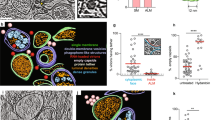Summary
Infection of PC12 cells with Japanese encephalitis (JE) virus caused marked proliferation of the protein secretory system. Accordingly, in this study the morphogenesis of the secretory orgenelles, i.e., rough endoplasmic reticulum (RER) and the Golgi apparatus, in JE virus-infected PC12 cells was analyzed by electron microscopical observation. Starting 24 h postinoculation (p.i.), a structure that represented nascent RER appeared in the cytoplasm in the form of rows of ribosomes which surrounded membrane-unbounded, electron-lucent lacunae in a reticular, honey-comb pattern (reticular RER). Although the reticular RER lacked membrane components, its lacunae contained progeny virions, indicating that the rows of ribosomes synthesized the viral proteins and discharged them into the lacunae for the viral assembly. The reticular RER apparently transformed into the familiar lamellar RER during the RER morphogenesis as the lacunae coalesced to form flat cisternae and RER membrane assembled to border the cisternae. These findings indicated that the proliferating RER was the site of not only active protein synthesis but also active membrane biogenesis. The proliferating RER released a large number of membrane vesicles including virion-carrying vesicles into the cytoplasm. These vesicles congregated in the juxtanuclear region, especially around the centrioles, and fused to existing Golgi complexes for enlargement or fused among themselves to form new Golgi complexes. The present study, therefore, indicated that (a) nascent RER was formed by polysomes that arranged themselves in rows of ribosomes without participation of a preexisting membrane framework of endoplasmic reticulum (ER), (b) membrane components of RER were assembled de novo within the structure during the RER morphogenesis, and (c) RER released membrane vesicles that moved to the Golgi apparatus and contributed to the morphogenesis of the Golgi apparatus. Possible causative mechanisms involved in the proliferation of the secretory system in JE virus-infected PC12 cells are discussed.
Similar content being viewed by others
References
Beaudoin AR, Grondin G (1991) Secretory pathways in animal cells: with emphasis on pancreatic acinar cells. J Electron Microsc Techn 17:51–69
Farquhar MG, Parade GE (1981) The Golgi apparatus (complex) −(1954–1981)—an artifact to center stage. J Cell Biol 91:77s-103s
Gilmore R, Blobel G (1983) Transient involvement of the signal recognition particle and its receptor in the microsomal membrane prior to protein translocation. Cell 35:677–685
Gilmore R, Blobel G, Walter P (1982a) Protein translocation across the endoplasmic reticulum. I. Detection in the microsomal membrane of a receptor for the signal recognition particle. J Cell Biol 95:463–469
Gilmore R, Walter P, Blobel G (1982b) Protein translocation across the endoplasmic reticulum. II. Isolation and characterization of the signal recognition particle receptor. J Cell Biol 95:470–477
Hase T, Summers PL, Eckels KH, Baze WB (1987) Maturation process of Japanese encephalitis virus in cultured mosquito cells in vitro and mouse brain cells in vivo. Arch Virol 96:135–151
Hase T, Summers PL, Eckels KH, Putnak JR (1989) Morphogenesis of flaviviruses. In: Harris JR (ed) Virally infected cells. Subcellular biochemistry, vol 15. Plenum, New York, pp 275–305
Hase T, Summers PL, Dubois DR (1990) Ultrastructural changes of mouse brain neurons infected with Japanese encephalitis virus. Int J Exp Pathol 71:493–505
Hase T, Summers PL, Ray P, Asafo-Adjei E (1992) Cytopathology of PC12 cells infected with Japanese encephalitis virus. Virchows Archiv B Cell Pathol 63:25–36
Kupfer A, Louvard D, Singer SJ (1982) Polarization of the Golgi apparatus and the microtubule organizing center in cultured fibroblasts at the edge of an experimental wound, Proc Natl Acad Sci USA 79:2603–2607
Kupfer A, Dennert G, Singer SJ (1983) Polarization of the Golgi apparatus and microtubule organizing center within cloned natural killer cells bound to their target. Proc Natl Acad Sci USA 80:7224–7229
McDowell EM, Trump BF (1976) Histologic fixatives suitable for diagnostic light and electron microscopy. Arch Pathol Lab Med 100:405–414
Meyer DI, Kraus E, Dobberstein B (1982) Secretory protein translocation across membrane—the role of the ‘docking protein’. Nature (Lond) 297:647–650
Monckton RP, Westaway EG (1982) Restricted translation of the genome of the Flavivirus Kunjin in vitro. J Gen Virol 63:227–232
Murphy FA, Harrison AK, Gary GW, Jr, Whitfield SG, Forrester FT (1968) St. Louis encephalitis virus infection of mice. Electron microscopic studies of central nervous system. Lab Invest 19:652–662
Sandoval IV, Bonifacino JS, Klausner RD, Henkart M, Wehland J (1984) Role of microtubules in the organization and localization of the Golgi apparatus. J Cell Biol 99:113–118
Svitkin YV, Ugarova TY, Chernovskaya TV, Lyapustin VN, Lashkevich VA, Agol VI (1981) Translation of tick-borne encephalitis virus (flavivirus) genome in vitro: synthesis of two structural polypeptides. Virology 110:26–34
Svitkin YV, Lyapustin VN, Lashkevich VA, Agol VI (1984) Differences between translation products of tick-borne encephalitis virus RNA in cell-free system from Krebs-2 cells and rabbit reticulocytes: involvement of membranes in the processing of nascent precursors of flavivirus structural proteins. Virology 135:536–541
Tassin AM, Paintrand M, Berger EG, Bornens M (1985) The Golgi apparatus remains associated with microtubule organizing centers during myogenesis. J Cell Biol 101:630–638
Walter P, Blobel G (1981a) Translocation of proteins across the endoplasmic reticulum II. Signal recognition protein (SRP) mediates the selective binding to microsomal membranes of in vitro assembled polysomes synthesizing secretory proteins. J Cell Biol 91:551–556
Walter P, Blobel G (1981b) Translocation of proteins across the endoplasmic reticulum. III. Signal recognition protein (SRP) causes signal sequence-dependent and site specific arrest of chain elongation that is released by microsomal membranes. J Cell Biol 91:557–561
Wengler G, Beato M, Wengler G (1979) In vitro translation of 42S virus-specific RNA from cells infected with the flavivirus West Nile virus. Virology 96:516–529
Author information
Authors and Affiliations
Rights and permissions
About this article
Cite this article
Hase, T. Morphogenesis of the protein secretory system in PC12 cells infected with Japanese encephalitis virus. Virchows Archiv B Cell Pathol 64, 229–239 (1993). https://doi.org/10.1007/BF02915117
Received:
Accepted:
Issue Date:
DOI: https://doi.org/10.1007/BF02915117




